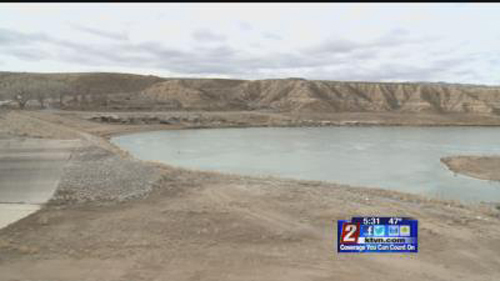
Report Date:
http://www.ktvn.com
KTVN Channel 2 - Reno Tahoe News Weather, Video -
Rye Patch Reservoir has been known for some of its large game fish, but a substantial fish die-off could have a huge impact on fish populations. After four years of drought, the man-made lake is only about 10% full, leaving its ecosystem vulnerable. The Nevada Department of Wildlife says Golden Algae is the reason for the die-off.
"This is new to us," Chris Healy, NDOW Spokesman said. "This is the first time we've had a body of water in northern Nevada where this has happened."
When large amounts of fish die, it often happens because of a lack of dissolved oxygen levels in the water. NDOW biologists investigated, and found that the levels were not low enough to cause it, in this case. That's when they knew something else contributed to the reservoir's decline. The culprit was the golden algae.
"When they're blooming and thriving, that's bad news for the fish because the golden algae actually attaches itself to the gills," Healy said. "It takes away the ability of the gills to absorb oxygen in the water."
Biologists say the water was the color of ice tea or root beer in the areas where the fish washed ashore. It is unknown how the aquatic invasive species got into the water system, but Healy says it could have come from a migratory bird, like a goose or duck. The lack of flowing water made the conditions perfect for the algae to bloom.
"The lack of fresh water coming into Rye Patch caused Rye Patch to become more and more salty, so to speak," Healy said.
40-percent of the dead fish are Sacramento Blackfish, and 35% are carp. The rest include channel catfish, walleye, wiper, white catfish, white crappie, black crappie, and smallmouth bass. Low numbers of minnow, speckled dace, Lahontan reside, and goldfish were also killed. Healy says replenishing the game fish populations will cost a lot of time and money.
"That's a big, long lake," Healy said. "So, it takes the warm water species such as walleye a number of years to grow into the densities where anglers can enjoy them and where the walleyes can go out there and reproduce."
The low water levels are not new to Rye Patch. The reservoir stores water to irrigate farmland in the Lovelock Valley. But farmers have not received any water allotments for two years. They got 10% in 2013.
"In the last three years, we basically haven't had any water to speak of," Bennie Hodges, Pershing County Water Conservation District Manager said.
Hodges says the lack of water has also had a negative impact on the recreation of Rye Patch Reservoir. He says visitors from Fernley, Lovelock, Winnemucca and Battle Mountain use the lake.
"They have a reputation, number one, as big of a trophy fishery for some of the warm water species of fish, and then everybody that goes there likes to boat and water ski," Hodges said. "They just haven't been able to do that for three years."
Hodges says the reservoir stretches 22 miles, but only 7.5 miles of it have water in it. The reservoir has a capacity of 200,000 acre-feet when it is full and Hodges says now there are only 10,000 acre-feet but he is hopeful that an above-average snowpack will help the water situation, this summer.
"Right now, it's too early to tell," Hodges said. "The only thing I can tell you is now we're the most optimistic we've been in three years."
Healy says small amounts of water are flowing into Rye Patch, and that will reduce the impact of the golden algae, for now. Since this problem is new to northern Nevada, he is not sure if it will go away or if it is here to stay.
"We now know that it's a part of that system," Healy said. "So, when we go back into a drought period, that'll be something else we'll have to worry about."
Healy says Texas has dealt with the same problems, created by golden algae. NDOW is learning more from wildlife officials in that state. The number of fish killed between October and December will not be know until the early spring, when NDOW can check populations.